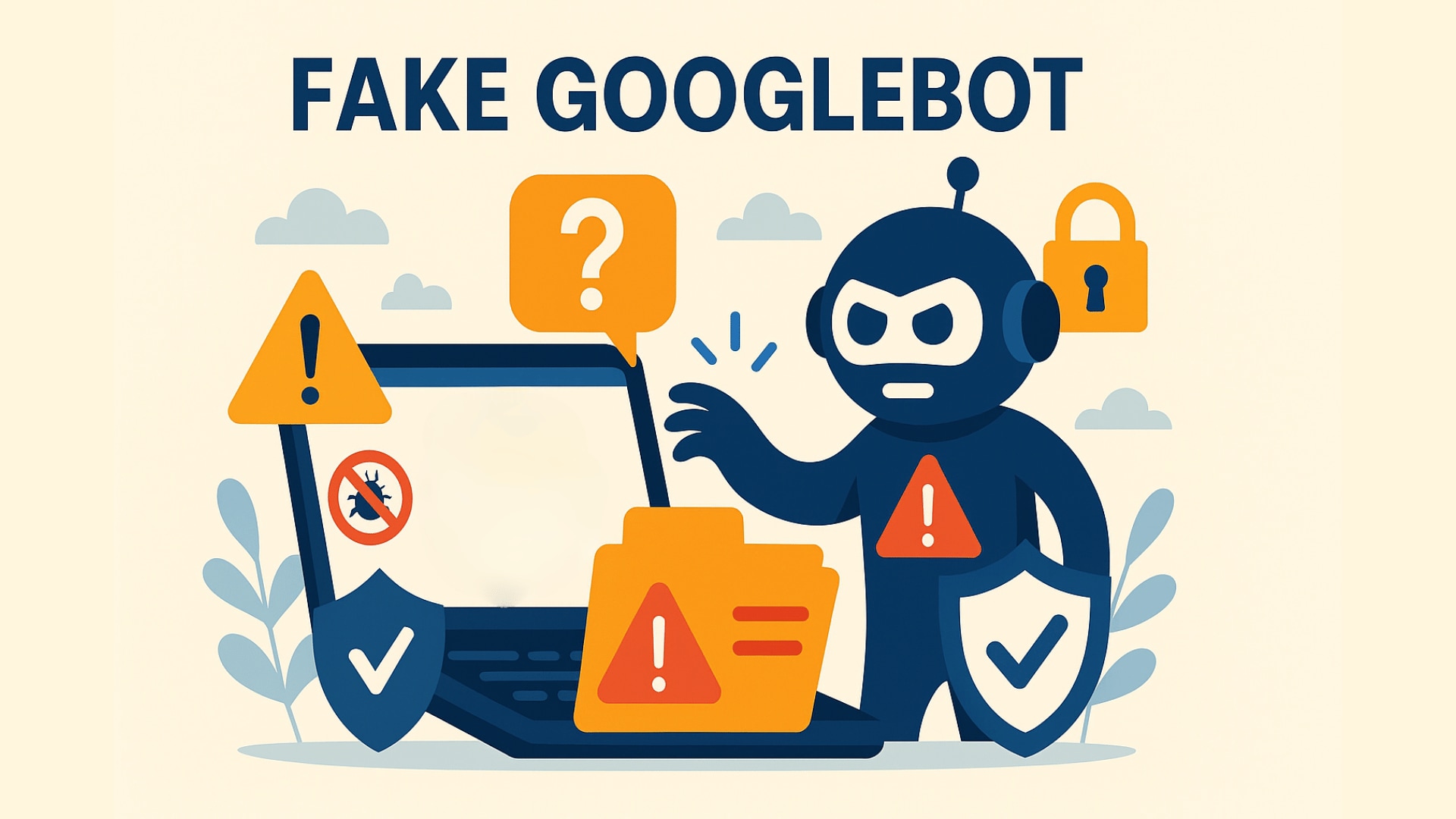
When you operate a website, seeing a visit from Googlebot is usually a good sign. Google’s official web crawler is responsible for indexing your site so that it can appear in search engine results. The more frequently your site is crawled, the quicker your content updates can appear in Google Search. But not every bot that claims to be Googlebot is legitimate. Increasingly, cybercriminals are deploying fake Googlebots — malicious bots designed to impersonate Google’s crawler and exploit your website’s openness to trusted agents.
Table of contents
- What Is a Fake Googlebot and Why Does It Exist?
- Threats that Fake Googlebots Bring to Your Website
- Why Fake Googlebots Are Effective at Bypassing Security
- Impact on SEO and Business Performance
- Identifying Fake Googlebots
- Strengthening Your Defenses Against Impersonators
- Conclusion
- FAQ – Frequently Asked Questions
What Is a Fake Googlebot and Why Does It Exist?
A fake Googlebot is an automated bot that pretends to be Google’s legitimate web crawler. It typically forges the user agent string to match that of the official Googlebot, and sometimes even mimics its behavior by visiting the robots.txt file first. This deception is designed to avoid detection and gain access to areas of a website that would otherwise be protected.
Website administrators tend to grant full access to Googlebot to ensure their content is indexed properly. Blocking or restricting this bot could have SEO consequences. Attackers exploit this trust, disguising malicious bots as Googlebot to bypass firewalls, rate limits, or CAPTCHA systems.
These impersonating bots can be used to steal content, overload your server, distort your traffic analytics, or map out your website for future attacks. They pose a significant cybersecurity risk, especially when left undetected.
Threats that Fake Googlebots Bring to Your Website
Unlike genuine web crawlers, fake Googlebots serve no positive function. They can siphon off your resources, expose your vulnerabilities, and undermine your site’s reputation. For instance, many fake bots engage in content scraping — copying your content to use it elsewhere without permission. This can result in duplicate content penalties from search engines and loss of competitive advantage.
Other fake bots may attempt to spam your forms, submit junk data, or probe for vulnerabilities in your CMS, plugins, or server configurations. The more aggressive ones can cause server slowdowns or even crashes due to high-frequency requests. If your server starts responding with error messages due to these fake requests, Google might reduce your crawl budget, negatively affecting your SEO.
In worst-case scenarios, fake Googlebots are just a first wave — testing your defenses before a broader attack. They may identify security gaps, gather data about your site structure, or act as components in distributed denial-of-service (DDoS) attacks.
Why Fake Googlebots Are Effective at Bypassing Security
Fake Googlebots succeed largely because most websites are configured to treat anything resembling Google’s crawler with caution. Admins are hesitant to block a visitor with “Googlebot” in the user agent, fearing a negative impact on their SEO. Exploiting this blind trust, impersonators can slip past standard bot protections and gain extensive access.
Moreover, many security tools rely heavily on user agent strings to identify traffic sources. Because these strings are easy to spoof, simple configurations may fail to detect the fraud. Even more advanced bots mimic Google’s crawling patterns, such as fetching the robots.txt file first, which further confuses detection systems.
This clever impersonation, when combined with rapid request frequency or headless browsing tools, makes fake Googlebots particularly challenging to identify using basic log analysis or traffic monitoring alone.
Impact on SEO and Business Performance
Beyond the immediate threats of scraping or server overload, fake Googlebots can have lasting effects on your SEO and overall business performance. Repeated server errors triggered by fake bots may cause Google to reduce its crawl budget for your site, meaning your new content gets indexed less frequently or not at all.
Analytics data can also become skewed, making it difficult to gauge the true behavior of real visitors. This distortion can lead to misguided marketing decisions, wasted ad spend, and ineffective content strategies. When fake bots dominate your traffic, real human users may experience degraded performance or downtime — resulting in poor user experience and potentially lost revenue.
Identifying Fake Googlebots
Distinguishing real from fake requires more than just checking user agent strings, which are easy to spoof. One reliable method is IP validation. Real Googlebots originate from specific Google-owned IP ranges. By performing a reverse DNS lookup, and then confirming that the hostname ends in googlebot.com or google.com (followed by a forward DNS lookup), you can verify the legitimacy of the IP address.
Monitoring behavior is another key step. Real Googlebot traffic is generally consistent, respectful of crawl rates, and avoids sensitive or restricted paths unless explicitly allowed. If you see erratic patterns, requests to admin paths, or bandwidth spikes, these are indicators of a fake bot.
Additionally, Google provides tools in its Search Console — such as the URL Inspection Tool and Crawl Stats Report—that let you validate whether recent crawls were performed by genuine Googlebot. Comparing your own server logs with these tools can help confirm suspicions.
Strengthening Your Defenses Against Impersonators
The best approach to preventing damage from fake Googlebots is a layered defense strategy. Begin by implementing proper IP validation rules. You can use firewalls or server configurations to allow only verified Googlebot IPs and block any impersonators.
Bot management solutions provide a higher level of sophistication. These tools use machine learning to assess request patterns, check for known malicious IPs, and dynamically adapt to emerging threats. They go beyond static blocklists and offer real-time protection against a wide range of automated abuses.
Maintaining a clean and up-to-date robots.txt file is still helpful, as legitimate bots adhere to its rules. But it’s important not to rely solely on it, as malicious bots tend to ignore these directives entirely.
Ongoing log monitoring also plays a vital role. Regularly reviewing server logs allows you to detect unusual access behavior, such as bots hammering your site at unnatural speeds, probing for hidden directories, or triggering a high rate of 404 or 5xx errors.
In cases where bots attempt to interact with login forms, comment sections or registration fields, CAPTCHA technology adds an important line of defense. Solutions, like those provided by captcha.eu, help ensure that access is granted only to humans. These tools are particularly effective at the application layer, where user interaction is required and fake bots are more likely to be blocked without degrading the user experience.
Conclusion
Fake Googlebots are a deceptive and potentially harmful class of automated traffic that exploit trust in Google’s crawler to gain illegitimate access to your website. They can steal content, skew your metrics, slow down performance, and even lay the groundwork for major attacks. Identifying and blocking them requires both technical vigilance and smart use of modern tools.
By combining DNS verification, behavior analysis, log monitoring and CAPTCHA systems, website operators can create a robust defense against this increasingly common threat. In particular, implementing intelligent, user-friendly CAPTCHA solutions like those from captcha.eu helps you maintain site security without sacrificing accessibility or compliance. As fake bots grow more sophisticated, your defenses must evolve too — because protecting your digital environment starts with knowing who (or what) is knocking at your door.
FAQ – Frequently Asked Questions
What is a fake Googlebot?
A fake Googlebot is a malicious web crawler that pretends to be Google’s legitimate crawler by spoofing its user agent or behavior. It does this to bypass security measures and gain access to content or resources that are normally protected or only accessible to trusted bots.
Why do attackers impersonate Googlebot?
Attackers impersonate Googlebot to exploit the trust that websites have in legitimate search engine crawlers. This trust allows them to scrape content, overload servers, hide malicious probing activity, and sometimes prepare for more serious cyberattacks such as DDoS or data breaches.
How can I tell if a Googlebot is fake?
You can verify a Googlebot by performing a reverse DNS lookup on its IP address. A legitimate Googlebot IP will resolve to a hostname ending in googlebot.com or google.com. You can confirm this by doing a forward DNS lookup to match the IP. Google’s Search Console tools can also help verify crawl activity.
Can fake Googlebots harm my website’s SEO?
Yes. Fake Googlebots can overload your server, leading to error responses (like 5xx errors), which can reduce your actual Googlebot crawl budget. They can also scrape your content and republish it elsewhere, resulting in duplicate content issues that harm your search rankings.
How can I block fake Googlebots?
Start by validating IPs and blocking those that fail DNS checks. Use firewalls and bot management tools that analyze behavior and detect anomalies. You can also implement CAPTCHA systems on sensitive entry points like login and form pages to filter out fake bots effectively.
100 free requests
You have the opportunity to test and try our product with 100 free requests.
If you have any questions
Contact us
Our support team is available to assist you.




